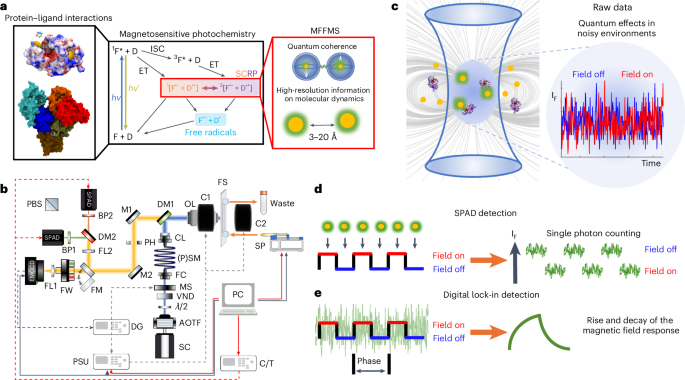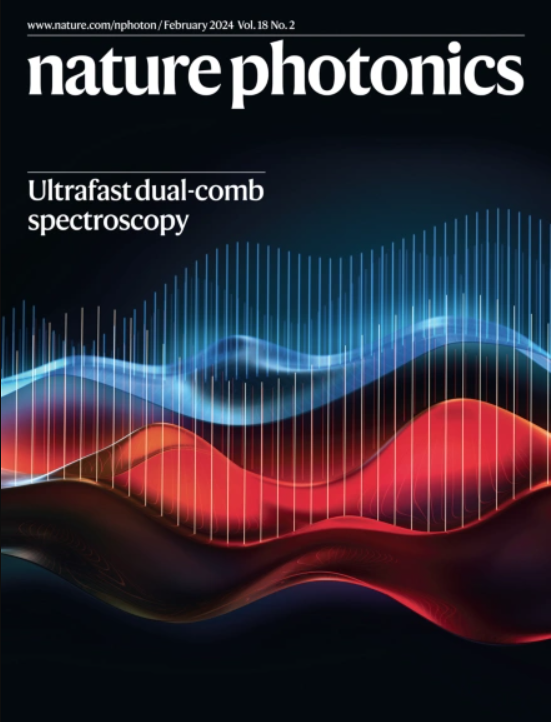磁荧光涨落微光谱学在生物学量子效应研究中的应用
IF 32.3
1区 物理与天体物理
Q1 OPTICS
引用次数: 0
摘要
磁场对化学体系中自由基对的影响通常被很好地理解,并已成功地用各种光谱技术进行了研究。然而,由于高灵敏度仪器的限制,对生物系统中自由基对及其量子性质的理解仍处于起步阶段。缺乏理解的另一个原因是由于生物化学反应的复杂性和磁场引起的自由基对反应的微小变化(低至或低于百分之一)。本文提出的系统设计是一种新的光学系统,以高信噪比捕捉生物的量子力学性质。我们的磁荧光波动微光谱方法能够用单光子雪崩二极管测量低至0.2%的荧光信号的单光子水平,并通过对23个分子的磁场效应进行了验证。EMCCD相机形式的附加检测系统提供空间分辨磁场效应,具有用于相敏相机检测的新型事后数字锁相放大器。上述性质在模型生物系统的自由基对光化学反应中得到了证明。该仪器揭示了光降解通过磁场效应对蛋白质-黄素相互作用的重要性,这将证明在生物环境中寻找类似量子效应时至关重要。本文章由计算机程序翻译,如有差异,请以英文原文为准。


Introduction of magneto-fluorescence fluctuation microspectroscopy for investigating quantum effects in biology
Magnetic field effects on radical pairs in chemical systems are generally well understood and have been successfully investigated with various spectroscopic techniques. However, understanding radical pairs and their quantum nature in biological systems is still in its infancy, which is due to the limitation of high-sensitivity instrumentation. Another reason for this lack of understanding is due to the complexity of biochemical reactions and minute magnetic field-induced changes on radical pair reactions (as low as or lower than a percent). The system design presented here is a new optical system to capture the quantum mechanical nature of biology with a high signal-to-noise ratio. Our magneto-fluorescence fluctuation microspectroscopic approach has the capability of measuring magnetic field effects as low as 0.2% on fluorescence signals near the single-photon level with single-photon avalanche diodes, and is demonstrated by magnetic field effects on 23 molecules. An additional detection system in the form of an EMCCD camera offers spatially resolved magnetic field effects with a novel post hoc digital lock-in amplifier for phase-sensitive camera detection. The aforementioned attributes are demonstrated with radical pair photochemical reactions on model biological systems. The instrument uncovers the importance of photodegradation on protein–flavin interactions via magnetic field effects, which will prove paramount when searching for similar quantum effects in biological locales. Quantum effects on biological reactions are investigated via magnetosensitive single-photon microspectroscopy. Using single-photon avalanche diode detectors, magnetosensitive radical pair photochemistry is detected to the single-photon level on 23 flavin molecules.
求助全文
通过发布文献求助,成功后即可免费获取论文全文。
去求助
来源期刊

Nature Photonics
物理-光学
CiteScore
54.20
自引率
1.70%
发文量
158
审稿时长
12 months
期刊介绍:
Nature Photonics is a monthly journal dedicated to the scientific study and application of light, known as Photonics. It publishes top-quality, peer-reviewed research across all areas of light generation, manipulation, and detection.
The journal encompasses research into the fundamental properties of light and its interactions with matter, as well as the latest developments in optoelectronic devices and emerging photonics applications. Topics covered include lasers, LEDs, imaging, detectors, optoelectronic devices, quantum optics, biophotonics, optical data storage, spectroscopy, fiber optics, solar energy, displays, terahertz technology, nonlinear optics, plasmonics, nanophotonics, and X-rays.
In addition to research papers and review articles summarizing scientific findings in optoelectronics, Nature Photonics also features News and Views pieces and research highlights. It uniquely includes articles on the business aspects of the industry, such as technology commercialization and market analysis, offering a comprehensive perspective on the field.
 求助内容:
求助内容: 应助结果提醒方式:
应助结果提醒方式:


